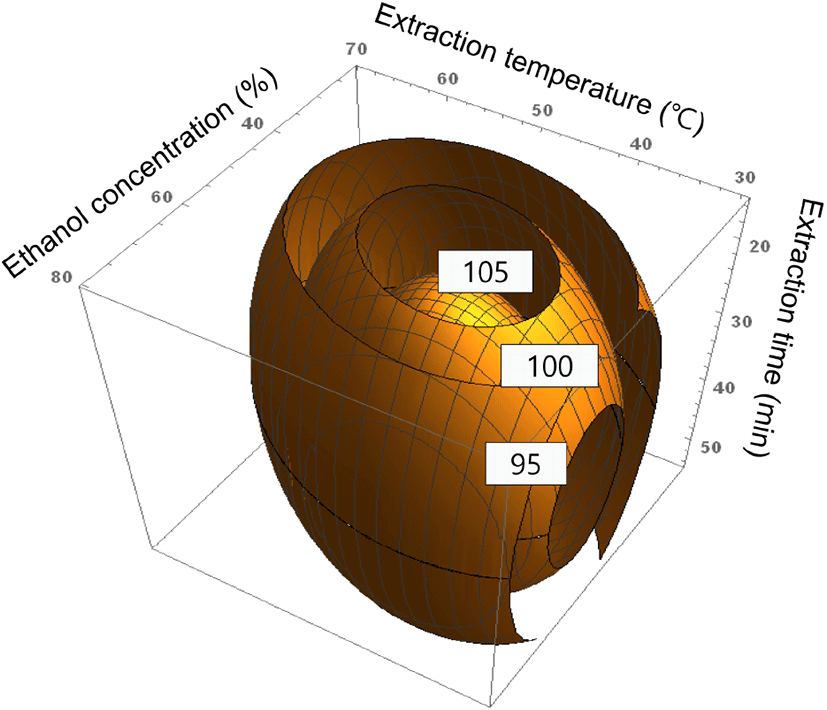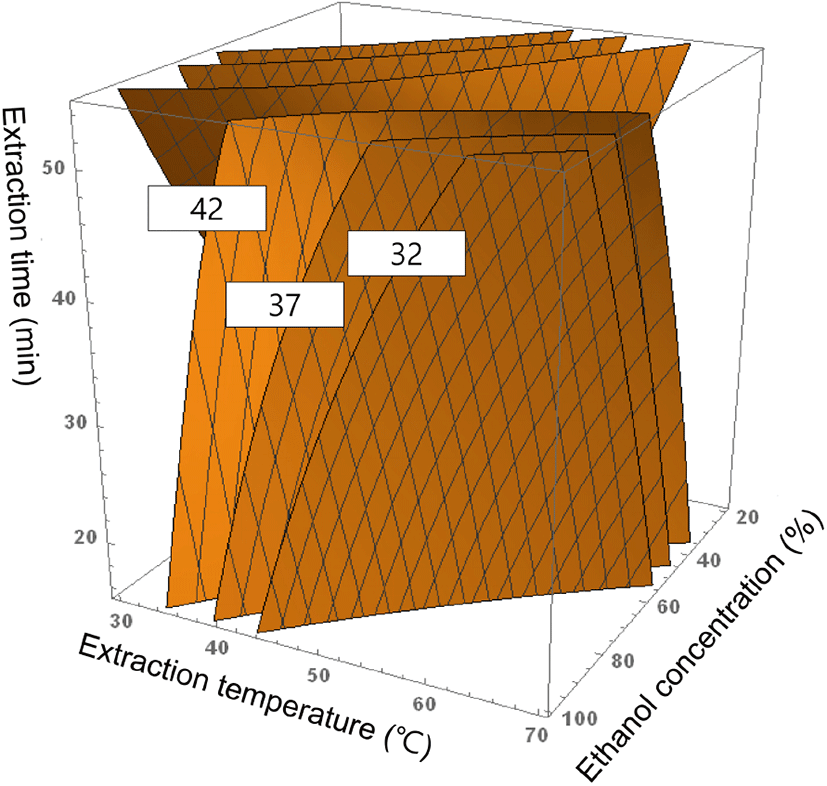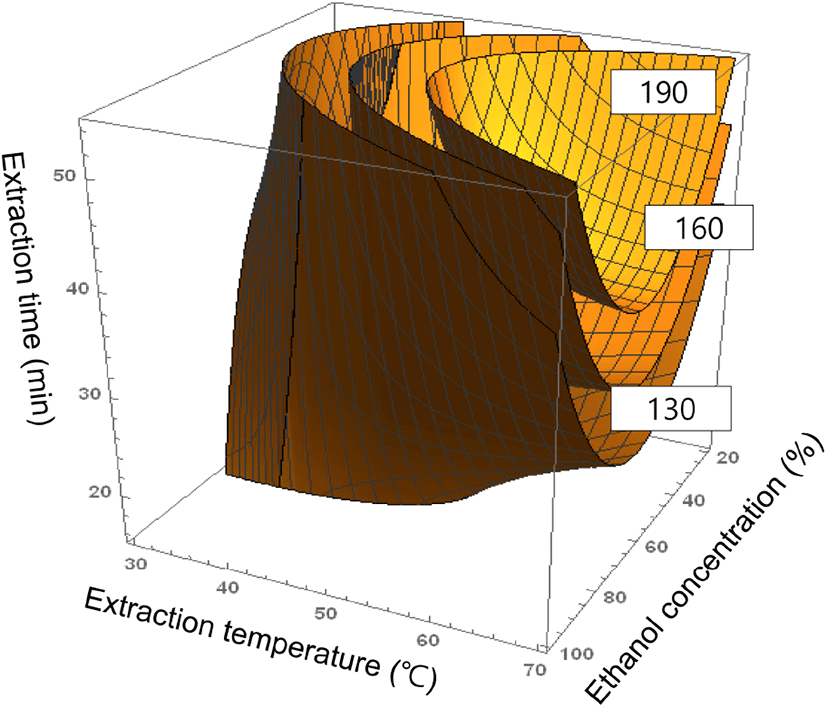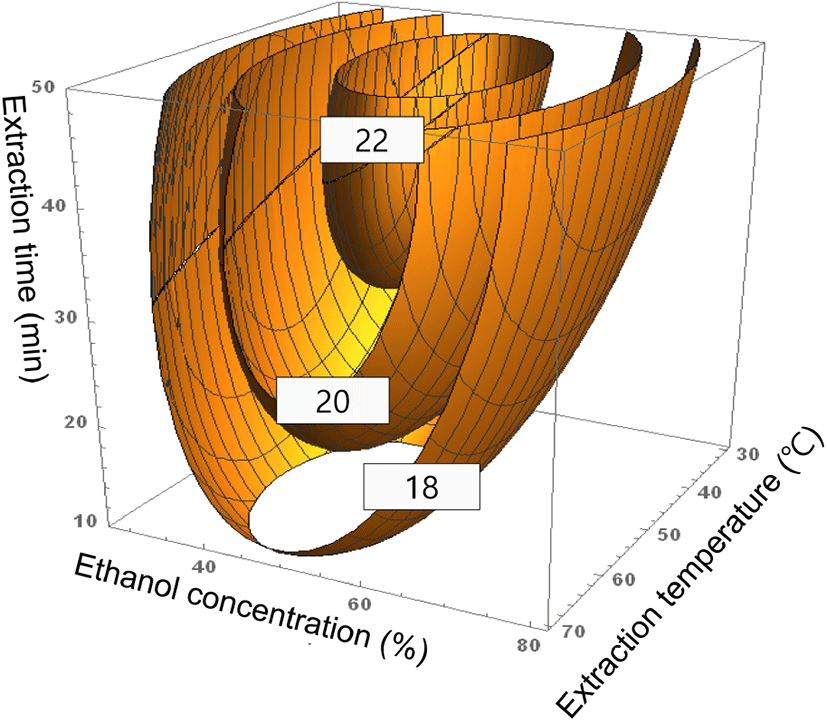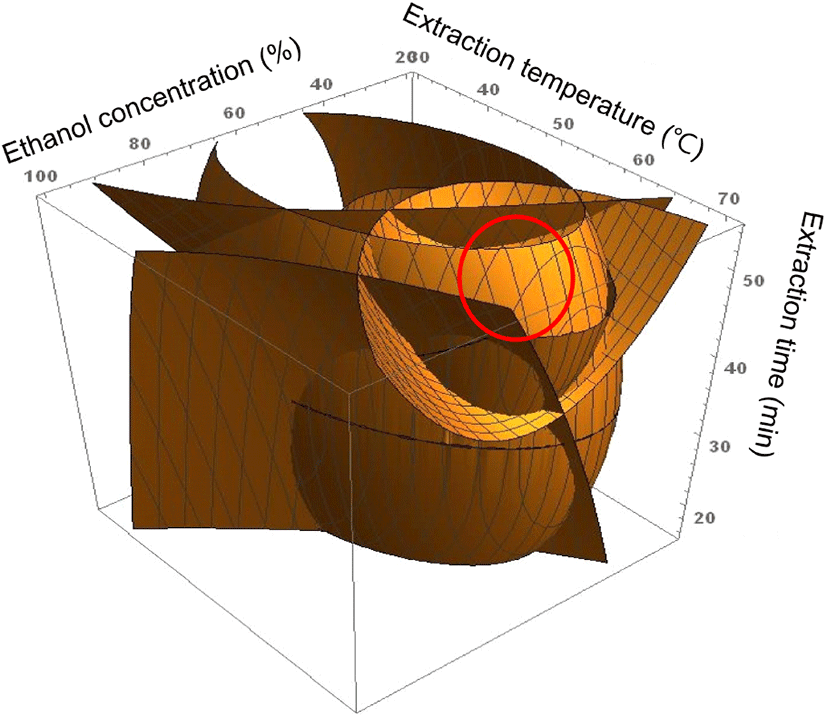Article
작약 뿌리의 유용성분 추출을 위한 초음파 추출조건 최적화
박광덕1
,
박종진1
,
이부쿠눌루와폴라올라위1
,
윤준현1
,
이소현2
,
최원석2
,
이창호2
,
이원영1,3,*
Optimization of ultrasound-assisted extraction of bioactive compounds from peony root (Paeonia japonica)
Gwang Deok Park1
,
Jong Jin Park1
,
Ibukunoluwa Fola Olawuyi1
,
Jun Hyun Yun1
,
So Hyeon Lee2
,
Won Seok Choi2
,
Chang Ho Lee2
,
Won Young Lee1,3,*
Author Information & Copyright ▼
1School of Food Science and Biotechnology, Kyungpook National University, Daegu 41566, Korea
2Gyeongbuk Institute for Bio Industry, Gyeongbuk 36618, Korea
3Research Institute of Tailored Food Technology, Kyungpook National University, Daegu 41566, Korea
Citation: Park GD, Park JJ, Olawuyi IF, Yun JH, Lee SH, Choi WS, Lee CH, Lee WY. Optimization of ultrasound-assisted extraction of bioactive compounds from peony root (Paeonia japonica). Korean J Food Preserv, 29(2), 301-310 (2022)
Copyright © The Korean Society of Food Preservation. This is an Open Access article distributed under the terms of the
Creative Commons Attribution Non-Commercial License (http://creativecommons.org/licenses/by-nc/4.0) which permits
unrestricted non-commercial use, distribution, and reproduction in any
medium, provided the original work is properly cited.
Received: Dec 06, 2021; Revised: Dec 17, 2021; Accepted: Dec 29, 2021
Published Online: Apr 30, 2022
4. 요약
본 연구는 작약 뿌리 추출물의 total phenolic compound, paeoniflorin, myricetin과 같은 생리활성 물질과 항산화 효과를 극대화하기 위해 초음파 추출 조건을 최적화하였다. 최적화를 위해 반응표면분석법을 이용하였으며, 각 지표의 4D 그래프를 superimposing하여 최적 조건을 도출하였다. 작약 추출의 최적의 조건은 에탄올 농도 40-50%, 추출 온도 60-65°C, 추출시간 40-50분 범위로 예측되었으며 예측 범위 내의 임의의 조건으로 추출물 제조 후 확인실험 결과 모델식의 적합성을 확인할 수 있었다.
Abstract
Peony root is a medicinal plant containing potent bioactive compounds. This study used response surface methodology (RSM) to optimize ultrasonic-assisted extraction (UAE) conditions of antioxidant compounds from peony roots. A central composite design consisting of extraction temperature (30-70°C), ethanol concentration (20-100% v/v), and extraction time (15-55 min) was used to determine the significance of each extraction condition on the total polyphenol, paeoniflorin, and myricetin contents and 2,2¢-azino-bis(3-ethylbenzothiazoline-6-sulfonic acid) (ABTS)- scavenging activity of the extracts. The ABTS-scavenging activity and myricetin content increased with an increasing extraction temperature. Further, at low ethanol concentrations, paeoniflorin and myricetin contents increased. Superimposition of 4D graphs revealed that an extraction temperature of 60-65°C, ethanol concentration of 40-50%, and extraction time of 40-50 min were optimal extraction conditions for peony root. A validation experiment was conducted using 45% ethanol at 63°C for 45 min. Under these UAE conditions, the experimental values of total polyphenol, paeoniflorin, and myricetin contents, and ABTS-scavenging activity were 101.80 mg GAE/g, 46.87 mg/g, 184.30 mg/g, and 23.13%, respectively. The validation experiment revealed slight differences between the experimental and predicted values (less than 10%), confirming the optimal UAE conditions for obtaining peony root antioxidant compounds via RSM. This study provides valuable information in developing functional food, medicine, and cosmetic using peony root extracts.
Keywords: peony root; ultrasound; antioxidant; response surface methodology
1. 서론
작약은 우리나라와 중국, 시베리아 남동부 등에서 생산되고 있는 약용 작물로서, 작약에 함유되어 있는 paeoniflorin, albiflorin 등의 생리활성 물질은 항산화, 항암 작용 및 면역 기능 촉진 효과 등의 기능성이 있다고 알려져 있다(Choung 등, 2003; Kim 등, 2007; Kim 등, 2015).
천연물의 기능성 성분을 추출하기 위해 감압 추출방법, 초음파 추출방법, 마이크로웨이브 추출방법(Jang 등, 2012; Kim 등, 2016; Lee, 2021) 등 다양한 방법이 적용되어 왔으며 본 연구에서는 초음파 추출방법이 적용되었다. 초음파 추출방법은 cavitation 현상에 의해서 생성되는 기포들이 파괴되면서 높은 온도와 압력이 순간적으로 일어나면서 추출 효율을 높여주게 된다(Shin과 Lee, 2011; Zhang 등, 2017). 하지만 추출 조건 및 초음파의 세기에 따라 생리활성 물질의 수율이 달라지기 때문에 목표물질의 분리와 이익 극대화를 위해서는 공정의 최적화는 필수이다(Bezerra 등, 2008; Jo과 Choi, 2011). 반응표면분석법(response surface methodology, RSM)은 공정의 최적화를 위해 사용되는 대표적 통계 기법으로 최소한의 비용과 시간으로 실제값에 근접한 최적 조건을 도출할 수 있다는 장점이 있다 (Bradley, 2007). 그래서 반응표면분석법은 차가버섯의 초음파 추출(Kim 등, 2012), cumin 초음파 추출(Shamsiev 등, 2021), 어묵 제조(Ra 등, 2020), 안젤리카 성분의 추출 (Lee 등, 2018) 등 선행 연구에서 공정 최적화를 위해 적용되어왔다. 하지만 작약 유효 성분을 얻기 위해 초음파 추출 조건을 최적화한 연구는 진행되지 않았다. 따라서 본 연구에서는 추출 시간, 에탄올 농도, 추출 온도를 공정 변수로 선정한 후 작약의 주요 생리활성 물질과 항산화 효과를 극대화할 수 있는 최적 추출 조건을 제시하고자 한다.
2. 재료 및 방법
2.1. 재료
실험에는 경북 영천에서 수확한 백작약(Paeonia japonica)을 사용하였다. 구입 시료는 50°C에서 24시간 동안 열풍건조 후 미세분쇄기(RT-04, Yung Kang, Taiwan)를 사용해서 분쇄하였으며 분말은 40 mesh와 80 mesh의 sieve를 이용하여 60 mesh 크기의 분말을 선별하였으며, 4°C에서 냉장 보관하면서 실험에 사용하였다.
2.2. 실험 설계
작약의 초음파 추출조건 최적화를 위해 central composite design(CCD)를 사용하였으며 Table 1과 같이 독립변수는 5단계(−2, −1, 0, 1, 2)로 에탄올 농도(X1: 20, 40, 60, 80, 100%), 추출 온도(X2: 30, 40, 50, 60, 70°C), 추출 시간(X3: 15, 25, 35, 45, 55 min), 종속변수는 total polyphenol contents, ABTS 소거활성, paeoniflorin, myricetin으로 설정하였다. 반응표면분석을 위해 statistical analysis system(Version 9.2, SAS Institute Inc., Cary, NC, USA)를 사용하였으며 도출된 모델식은 Mathematica 11(Mathematica, Wolfram, Champaign, IL, USA)을 통해 4차원 그래프로 표현되었다.
Table 1.
The central composite design for optimization of ultrasound extraction conditions of peony root
| Xn |
Response variables |
Levels |
| −2 |
−1 |
0 |
1 |
2 |
| X1 |
Ethanol concentration (%) |
20 |
40 |
60 |
80 |
100 |
| X2 |
Extraction temperature (°C) |
30 |
40 |
50 |
60 |
70 |
| X3 |
Extraction time (min) |
15 |
25 |
35 |
45 |
55 |
Download Excel Table
2.3. 추출 방법
추출물 제조를 위해 0.5 g 백작약 분말에 에탄올(Duksan Company, Ansan-si, Gyeonggi-do, Korea) 30 mL를 넣은 후 Table 2에 설계된 실험 조건에서 초음파 추출기 (KHC-1SUMP, Kyung Il ultrasonic Co., Ltd, Ansan, Korea)로 추출을 진행하였다. 추출액은 4,000 rpm에서 10분 간 원심분리 후 여과하였으며 여과액은 4°C에서 냉장보관하면서 분석용 시료로 사용되었다.
Table 2.
Central composite design for ultrasound extraction from peony root and the total polyphenolic content, ABTS, Paeoniflorin, Myricetin of the extracts
|
|
Independent variables |
Dependent variables |
| Ethanol concentration (%) X1 |
Extraction temperature (°C) X2 |
Extraction time (min) X3 |
TPC (mg GAE/g) |
ABTS (%) |
Paeoniflorin (mg/g) |
Myricetin (mg/g) |
| 1 |
40(−1) |
40(−1) |
25(−1) |
103.32 |
19.32 |
44.11 |
147.1 |
| 2 |
40(−1) |
40(−1) |
45(1) |
103.32 |
20.13 |
31.42 |
145.4 |
| 3 |
40(−1) |
60(1) |
25(−1) |
108.25 |
20.1 |
45.61 |
115.9 |
| 4 |
40(−1) |
60(1) |
45(1) |
107.48 |
22.86 |
44.71 |
179.2 |
| 5 |
80(1) |
40(−1) |
25(−1) |
94.72 |
16.42 |
45.39 |
118 |
| 6 |
80(1) |
40(−1) |
45(1) |
94.23 |
16.45 |
44.30 |
126.6 |
| 7 |
80(1) |
60(1) |
25(−1) |
90.21 |
18.73 |
34.08 |
125.1 |
| 8 |
80(1) |
60(1) |
45(1) |
90.03 |
19.42 |
39.57 |
174.1 |
| 9 |
60(0) |
50(0) |
35(0) |
102.31 |
21.89 |
42.79 |
172.3 |
| 10 |
60(0) |
50(0) |
35(0) |
101.52 |
21.47 |
44.76 |
167 |
| 11 |
20(−2) |
50(0) |
35(0) |
90.62 |
17.95 |
42.01 |
143.4 |
| 12 |
100(−2) |
50(0) |
35(0) |
58.78 |
9.83 |
29.79 |
43 |
| 13 |
60(0) |
30(−2) |
35(0) |
103.67 |
19.09 |
43.45 |
123.3 |
| 14 |
60(0) |
70(−2) |
35(0) |
79.07 |
18.27 |
34.70 |
187.5 |
| 15 |
60(0) |
50(0) |
15(−2) |
95.79 |
19.49 |
42.24 |
137.2 |
| 16 |
60(0) |
50(0) |
55(−2) |
97.15 |
21.26 |
42.66 |
194 |
Download Excel Table
2.4. 총폴리페놀 함량(total polyphenol contents, TPC)
TPC 측정은 Folin-Ciocalteu method방법(Singleton 등, 1999)을 변형시켜 측정하였다. 먼저 증류수로 2배 희석한 추출물 100 μL에 50 μL Folin reagent(Sigma Aldrich Co., St Louis, MO, USA), 300 μL 2% Na2CO3 (Duksan Company, Ansan-si, Gyeonggi-do, Korea)를 첨가하고 voltexing하였다. 혼합물을 15분 암실에서 반응시킨 다음 증류수 1,000 μL를 첨가하였으며 반응이 완료된 시료는 725 nm으로 설정된 UV-VIS spectrophotometer (Shimazdu Co., UV-2550, Tokyo, Japan)을 이용하여 흡광도를 측정하였다. 측정된 흡광도는 mg of gallic acid equivalent (GAE)/g으로 환산하여 나타내었다.
2.5. ABTS radical 소거활성 측정
ABTS radical 소거활성 측정은 Marino B. Arnao (Arnao 등, 2001)의 방법을 변형시켜 측정하였다. 용액은 0.0406 g 2 2’-azinobis(3-ethylbenzothiazolin-6-sulfonic acid) diammonium salt(Sigma Aldrich Co., St Louis, MO, USA)에 0.007 g potassium persulfate(Daejung Chemicals & Metals Company, Siheung, Gyeonggi-do, Korea)과 증류수 10 mL를 첨가한 후에 voltexing을 진행하고 암실에서 12시간 이상 반응 후에 증류수에 60배 희석하여 사용하였다. 실험은 증류수로 10배 희석한 추출물 50 μL에 ABTS 용액 950 μL 첨가 및 voltexing 후 암실에서 30분동안 반응을 시켰으며, 734 nm로 설정된 UV-VIS spectrophotometer(Shimazdu Co., UV-2550, Tokyo, Japan)를 이용하여 반응이 완료된 시료의 흡광도를 측정하였다. 측정된 흡광도는 아래 식을 이용하여 ABTS 소거활성(%)으로 나타내었다.
2.6. Paeoniflorin 및 myricetin 함량 분석
Paeoniflorin, myricetin 함량은 Seal의 방법(Seal, 2016)을 변형시켜 측정하였다. HPLC 분석 전 추출물은 0.2 μm syringe filter(D2520, Echrome Science, Daegu, Korea)를 이용해서 여과한다음 사용되었다. 분석에는 Athena C18 역상 컬럼(250 mm×4.6 mm, 5 μm), UV/VIS 검출기(UV-2075 plus, Jasco International Co., Ltd., Tokyo, Japan) 및 4차 구배 펌프(PU2089 Plus, Jasco International Co., Ltd., Tokyo, Japan)로 구성된 고성능 액체 크로마토크래피 시스템을 사용하였다. 이동상으로는 (A) 1% acetic acid와 (B) acetonitrile을 사용하였으며 유속 0.7 mL/min으로 10-40% B(0-28분), 40-10% B(28-32분), 10% B(32-36분)와 같이 gradient를 주었다. 분석 시 시료 주입량은 20 μL이며 UV 검출기는 272 nm로 설정하였다. 검출된 peak의 정성 및 정량 분석을 위해 paeoniflorin(Fujifilm Wako Pure Chemical Co., Osaka, Japan)과 myricetin(Sigma Aldrich Co., St. Louis, MO, USA)을 표준물질로 사용하였다.
3. 결과 및 고찰
3.1. 추출조건이 TPC에 미치는 영향
TPC는 여러 생리활성을 나타내는 화합물이다(Kim 등, 2013). 초음파 추출 조건에 따른 작약의 TPC의 변화는 Fig. 1과 같으며 모델식은 다음과 같다.
Fig. 1.
Effect of ultrasound extraction conditions on the total polyphenol content of peony root.
Download Original Figure
TPC에 대한 모델식 R2값은 0.8213으로 stationary point에서 maximum을 나타내었으며 에탄올 농도 49.84%, 추출온도 42.27°C, 추출시간 52.73분 조건에서 103.62 mg GAE/g으로 최대값을 나타내는 것으로 예측되었다(Table 3).
전반적으로 TPC는 추출 온도, 추출 시간에 비례하여 증가하다가 추출온도 50°C, 추출시간 60분 이후로 감소하는 경향을 보였다. 높은 추출 온도의 적용은 세포벽을 약화시키고 성분의 용해도와 확산계수를 증가시켜 물질의 추출을 증가시킬 수 있다(Alonso 등, 2001). 하지만 본 연구에서 나타난 특정 온도 및 추출 시간 이상에서 TPC의 감소 추세는 과한 가열처리가 가수분해, 중합반응을 유발하여 페놀성 물질을 파괴시켰기 때문에 나타난 것으로 사료된다.
또한, 본 연구에서는 에탄올 농도 20%부터 60%까지 TPC가 증가하였으나 60% 이상부터는 TPC 추출이 감소하는 경향을 보였다. 이와 유사하게 선행연구에서도 증류수 또는 순수 유기용매보다 물로 희석된 유기용매의 추출 효율이 높다고 보고되었다(Park과 Lee, 2016). 이는 물이 용질을 팽창시켜 에탄올의 용질의 polyphenolic bonds를 파괴를 촉진한 것이 TPC 추출에 영향을 미친 것으로 보인다(Ćujić 등, 2016).
3.2. 추출조건이 paeoniflorin 함량에 미치는 영향
Paeoniflorin은 항염 효과, 면역조절 효과 등이 보고된 작약 뿌리의 대표적인 지표물질이다(Xin 등, 2019). 초음파 추출 조건에 따른 작약의 paeoniflorin 함량 변화 예측식은 아래와 같다.
예측식에서 R2값은 0.8508, stationary point는 saddle point이며 paeoniflorin의 최대값은 48.37 mg/g으로 에탄올 농도 55.11%, 추출 온도 39.29°C, 추출 시간 18.28분에서 나타났다(Table 3). Fig. 2 결과로 볼 때 paeoniflorin은 15-55분 범위에서 추출 시간에 따른 영향은 적었으나, 에탄올 농도가 낮을수록 paeoniflorin 함량이 증가하는 것을 확인하였다. 이와 유사하게 Kim 등(1996), Chen 등(2017)의 연구에서 paeoniflorin은 순수한 물에는 잘 녹지 않는다고 하였으며, Zhang 등(2010)은 낮은 에탄올 농도가 paeoniflorin의 추출에 적합하다고 보고하였다. 반면 추출 온도가 낮을수록 paeoniflorin 함량은 증가하였는데 이는 paeoniflorin의 열안정성이 낮아 추출 중 열분해가 발생한 것으로 사료된다(Cho 등, 2009).
Table 3.
The second polynomial equations for quality prediction of peony root
|
|
The second polynomial equations |
R2 |
Significance |
Stationary point |
| TPC |
−35.347188 + 2.230000(X1) + 3.3018750(X2) + 0.985875(X3) − 0.017009(X12) − 0.011125(X1 × X2 – 0.026363(X22) + 0.000062500(X1 × X3) − 0.00575(X2 × X3) − 0.013612(X32) |
0.8213 |
0.0932 |
Maximum |
| ABTS |
−11.811875 + 0.504938(X1) + 0.614125(X2) + 0.221062(X3) − 0.004869(X12) + 0.001106(X1 × X2) − 0.007500(X22) − 0.001781(X1 × X3) + 0.003263(X2 × X3) − 0.003262(X32) |
0.9289 |
0.008** |
Maximum |
| Paeoniflor |
11.776875 + 1.076313(X1) + 1.410250(X2) − 1.643063(X3) − 0.004922(X12) − 0.019269(X1 × X2) − 0.011750(X22) + 0.011244(X1 × X3) + 0.022963(X2 × X3) − 0.003313(X32) |
0.8508 |
0.059 |
Saddle point |
| Myricetin |
153.653125 + 3.431875(X1) − 1.838750(X2) − 4.273750(X3) − 0.047781(X12) + 0.032500(X1 × X2) − 0.035625(X22) − 0.002500(X1 × X3) + 0.131750(X2 × X3) − 0.010125(X32) |
0.9018 |
0.0195* |
Saddle point |
Download Excel Table
3.3. 추출조건이 myricetin 함량에 미치는 영향
Myricetin은 폴라보노이드의 한 성분으로 혈관 산소 공급 기능뿐만 아니라 단백질과 세포 증식을 촉진하는 신호 전달 경로를 억제하는 효과 및 세포 사멸을 억제하는 효과를 가지고 있어 항암효과를 나타내며, 면역 수용체 활성 효과 및 높은 항염증 효과를 가진 생리활성 물질이다(Song 등, 2021). 초음파 추출 조건에 따른 작약 내 myricetin 함량 변화 예측식은 아래와 같다.
예측식의 R2값은 0.9018로 stationary point는 saddle point로 나타났다. 그리고 myricetin의 최대값은 222.83 mg/g으로 최적 조건은 에탄올 농도 57.16%, 추출 온도 62.46°C, 추출 시간 50.58분으로 예측되었다(Table 3). 전반적으로 myricetin은 추출온도와 추출시간에 비례하여 증가하였다. Ali 등(2018)은 myricetin이 추출 온도 60°C 이상부터 열분해된다고 보고하였다. 하지만 본 연구에서 Myricetin은 추출온도와 추출시간에 비례하여 증가하는 추세를 보였다. 이는 본 연구의 추출조건에서 열분해로 인한 myricetin의 손실보다 시료에서 추출되는 myricetin의 양이 더 우세하기 때문에 나타난 것으로 사료된다. 반면 동일한 추출온도와 추출시간일 때 에탄올 농도가 60% 이하일 때 myricetin은 에탄올 농도에 비례하여 증가하였으며 에탄올 농도가 60% 이상부터는 감소하였다(Fig. 3). 선행연구에서 위 결과와 일치하는 연구 결과를 보고하였다(Chen 등, 2008; Olawuyi 등, 2020). Myricetin은 물보다 유기용매에 대한 용해도가 높은 것으로 알려져 있다(Devi 등, 2015; Yao 등, 2014). 하지만 본 연구와 같이 특정 에탄올 농도 이상에서 추출물 내 함량이 감소하는 것은 특정 농도구배의 에탄올 용액이 용질 내로 확산이 잘 이루어졌고, 그 결과가 myricetin의 추출 효율에 영향을 준 것으로 사료된다(Ali 등, 2018).
3.4. 추출조건이 ABTS radical 소거활성 소거활성에 미치는 영향
ABTS radical 소거활성은 항산화 측정 지표로써(Naknaen과 Itthisoponkul, 2015) 초음파 추출 조건에 따른 작약의 ABTS radical 소거활성의 변화는 Fig. 4과 같으며 예측식은 다음과 같다.
Fig. 4.
Effect of ultrasound extraction conditions on the ABTS scavenging activity of peony root.
Download Original Figure
예측식에서 ABTS radical 소거활성의 R2값은 0.9289로 높은 적합성을 나타내었으며 stationary point에서 maximum을 나타내었다. 예측 결과에 따르면 ABTS radical 소거활성은 에탄올 농도 48.18%, 추출 온도 56.63°C, 추출 시간 52.92분일 때 22.76%로 최대값을 나타내었다(Table 3). 전반적으로 ABTS radical 소거활성은 에탄올 농도 40-60% 범위에서 가장 높았으며 추출 시간에 비례하여 증가하였다. 반면 ABTS radical 소거활성은 특정 범위 온도까지 증가하다가 감소하는 추세를 나타내었다. 추출조건에 따른 ABTS radical 소거활성의 차이는 TPC와 paeoniflorin 및 myricetin을 포함한 여러 항산화물질의 변화가 복합적으로 영향을 미친 것으로 보인다. 추출 시간이 길어질수록 용매와 시료 간의 반응 시간이 증가하여 항산화물질의 추출을 증가시킬 수 있으나 장시간의 추출은 항산화물질의 분해를 유발하여 ABTS radical 소거활성은 특정 시간 이후부터 감소할 수 있다(Chew 등, 2011; Ghafoor 등, 2009). 하지만 Fig. 4에서 ABTS radical 소거활성은 추출시간에 비례하여 증가하였다. 이는 본 연구의 추출 조건 범위 내에서는 추출 시간이 증가할수록 ABTS radical 소거활성을 나타내는 항산화물질의 추출이 증가함을 나타낸다.
Table 4.
Confirmation of optimal conditions for ultrasound extraction of peony root
|
|
TPC (mg GAE/g) |
ABTS (%) |
Paeoniflorin (mg/g) |
Myricetin (mg/g) |
| Predicted value |
99.86 |
22.09 |
45.05 |
201.86 |
| Experimental value |
101.79 |
23.13 |
46.87 |
184.32 |
| Error (%) |
1.93 |
4.71 |
4.04 |
−8.69 |
Download Excel Table
3.5. 최적 추출조건 확인
이전 결과를 통해 각 지표 별 최적 추출 조건이 다름을 확인하였다. 따라서 높은 유효성분 함량과 항산화효과를 얻을 수 있는 최적 추출 조건을 찾기 위해 종속변수의 4D 그래프를 superimposing하였다(Fig. 5). 그 결과 에탄올 농도 40-50%, 추출 온도 60-65°C, 추출 시간 40-50분이 최적 추출 조건 범위임을 확인할 수 있었다. 예측식의 정확성을 검증하기 위해 최적 추출 조건 범위 내 임의의 조건(에탄올 농도 45%, 추출 온도 63°C, 추출시간 45분)으로 추출한 후 예측값과 실험값을 비교하였다(Table 4). 최적 추출 조건에서 실험값은 TPC는 101.79 mg GAE/g, ABTS radical 소거활성은 23.13%, paeoniflorin은 46.87 mg/g, myricetin은 184.32 mg/g으로 실험값과 약 8.7% 이내의 오차를 나타내며 예측식의 적합성을 검증할 수 있었다.
Fig. 5.
Superimposed response surfaces at optimum ultrasound extraction conditions for peony root.
Download Original Figure
감사의 글
본 연구는 경상북도가 지원한 네이처 생명산업 기술개발사업으로 수행한 연구결과입니다.
References
Ali A, Lim XY, Chong CH, Mah SH, Chua BL. Optimization of ultrasound-assisted extraction of natural antioxidants from
Piper betle using response surface methodology. LWT-Food Sci Technol, 89, 681-688 (2018)


Alonso Salces RM, Korta E, Barranco LA, Berrueta LA, Gallo B, Vicente F. Pressurized liquid extraction for the determination of polyphenols in apple. J Chromatogr A, 933, 37-43 (2001)


Arnao MB, Cano A, Acosta M. The hydrophilic and lipophilic contribution to total antioxidant activity. Food Chem, 73, 239-244 (2001)


Bezerra MA, Santelli RE, Oliveira EP, Villar LS, Escaleira LA. Response surface methodology (RSM) as a tool for optimization in analytical chemistry. Talanta, 76, 965-977 (2008)

,


Bradley N. The Response Surface Methodology. Ms thesis Indiana University South Bend, United States of America, p 1-73 (2007)

Chen F, Mo K, Zhang Q, Fei S, Zu Y, Yang L. A novel approach for distillation of paeonol and simultaneous extraction of paeoniflorin by microwave irradiation using an ionic liquid solution as the reaction medium. Sep Purif Technol, 183, 73-82 (2017)


Chen L, Jin H, Ding L, Zhang H, Li J, Qu C, Zhang H. Dynamic microwave-assisted extraction of flavonoids from
Herba Epimedii. Sep Purif Technol, 59, 50-57 (2008)


Chew K, Khoo M, Ng SY, Thoo YY, Aida WM, Ho CW. Effect of ethanol concentration, extraction time and extraction temperature on the recovery of phenolic compounds and antioxidant capacity of
Orthosiphon stamineus extracts. Int Food Res J, 18, 1427-1435 (2011)

Cho WG, Kyung KY, Yu SM. Stability of paeoniflorin used as anti-wrinkle agents in emulsions. J of Korean oil chemists soc, 26, 191-198 (2009)

Choung MG, An YN, Kang KH, Cho YS, Kim JH. Comparison on the extract content by different processing method in Peony (
Paeonia lactiflora Pall.) root. Korean J Medicinal Crop Sci, 11, 201-206 (2003)

Cujic N, Savikin K, Jankovic T, Pljevljakusic D, Zdunic G, Ibric S. Optimization of polyphenols extraction from dried chokeberry using maceration as traditional technique. Food Chem, 194, 135-142 (2016)

,


Devi KP, Rajavel T, Habtemariam S, Nabavi SF, Nabavi SM. Molecular mechanisms underlying anticancer effects of myricetin. Life Sci, 142, 19-25 (2015)

,


Ghafoor K, Choi YH, Jeon JY, Jo IH. Optimization of ultrasound-assisted extraction of phenolic compounds, antioxidants, and anthocyanins from grape (
Vitis vinifera) seeds. J Agric Food Chem, 57, 4988-4994 (2009)

,


Ghasemzadeh A, Jaafar HZ, Karimi E, Rahmat A. Optimization of ultrasound-assisted extraction of flavonoid compounds and their pharmaceutical activity from curry leaf (
Murraya koenigii L.) using response surface methodology. BMC Complementary Altern Med, 14, 1-10 (2014)

,

,


Jang GY, Kim HY, Lee SH, Kang Y, Hwang IG, Woo KS, Kang TS, Lee J, Jeong HS. Effects of heat treatment and extraction method on antioxidant activity of several medicinal plants. J Korean Soc Food Sci Nutr, 41, 914-920 (2012)


Jeong JY, Park HJ, Kim BH, Kim SS. Effects of extraction time on the quality characteristics of purple corn cob extract. J Appl Biol Chem, 58, 339-344 (2015)


Jo IH, Choi YH. Optimization of extraction of functional components from black rice bran. J Food Process Eng, 15, 388-397 (2011)

Kim DY, Teng H, Choi YH. Optimization of ultrasonic-assisted extraction process for
inonotus obliquus using response surface methodology. Cult Res Agric Life Sci, 30, 68-75 (2012)

Kim HS, Kim MS, Kim SH, Yun KW, Song JH. Analysis of total phenolic content and antioxidant activity from fruits of
Vaccinium oldhamii Miq. J Korean For Soc, 102, 566-570 (2013)


Kim MY, Yoon BY, Ko KS. Study on cosmeceutical activities of
Paeonia japonica extracts. J Kor Soc Beauty Cultural Arts, 4, 23-30 (2015)

Kim MY, Yoon BY, Ko KS. Study on cosmeceutical activities of
Paeonia japonica ethanol extracts. J Kor Soc Cosmetol, 22, 818-823 (2016)

Kim SJ, Park JH, Choi SY, Son KH, Kim KU. Isolated and identification of biological activity compounds from leaves and stem of
Paeonia lactiflora pallas. Korean J Medicinal Crop Sci, 15, 6-11 (2007)

Kim TK, Joo GJ, Chung JD, Rhee IK. Analysis of the content of paeoniflorin in peony roots cultivated on kyeongbuk area. Agric Res Bull Kyungpook Natl Univ, 14, 15-28 (1996)

Lee H, Jang KW. Development of microwave extraction method for the active ingredients and functional constituents of paeonia root. Korean J Pharmacogn, 52, 157-162 (2021)

Lee SB, Park BR, Hong IK. Optimization of extraction process for total polyphenols from angelica using response surface methodology. Appl Chem Eng, 29, 325-329 (2018)

Olawuyi IF, Park JJ, Lee WY. Effect of extraction conditions on ultrasonic-assisted extraction of polyphenolic compounds from okra (
Abelmoschus esculentus L.) leaves. Korean J Food Preserv, 27, 476-486 (2020)


Park JJ, Lee WY. Prediction of optimal microwave extraction conditions for functional compounds from
Agrimonia pilosa ledeb using response surface methodology. Korean J Medicinal Crop Sci, 24, 263-270 (2016)


Ra HN, Park SR, Cho YS, Hwang Y, Jang HW, Kim KM. Optimizing of
Eomuk manufacturing condition utilizing rice material using response surface methodology. J Food Eng Prog, 24, 276-284 (2020)


Re R, Pellegrini N, Proteggente A, Pannala A, Yang M, Rice-Evans C. Antioxidant activity applying an improved ABTS radical cation decolorization assay. Free Radic Biol Med, 26, 1231-1237 (1999)


Saad WZ, Hashim M, Ahmad S, Abdullah N. Effects of heat treatment on total phenolic contents, antioxidant and anti-inflammatory activities of pleurotus sajor-caju extract. Int J Food Prop, 17, 219-225 (2014)


Seal T. Quantitative HPLC analysis of phenolic acids, flavonoids and ascorbic acid in four different solvent extracts of two wild edible leaves,
Sonchus arvensis and
Oenanthe linearis of north-eastern region in India. J App Pharm Sci, 6, 157-166 (2016)


Shamsiev A, Park JJ, Olawuyi IF, Odey G, Lee WY, Optimization of ultrasonic-assisted extraction of polyphenols and antioxidants from cumin (
Cuminum cyminum L.). Korean J Food Preserv, 28, 510-521 (2021)


Shin SL, Lee CH. Antioxidant activities of ostrich fern by different extraction methods and solvents. J Life Sci, 21, 56-61 (2011)


Singleton VL, Orthofer R, Lamuela-Raventos RM. Analysis of total phenols and other oxidation substrates and antioxidants by means of folin-ciocalteu reagent. Meth Enzymol, 299, 152-178 (1999)


Song X, Tan L, Wang M, Ren C, Guo C, Yang B, Ren Y, Cao Z, Li Y, Pei J. Myricetin: A review of the most recent research. Biomed Pharmacother, 134, 111017 (2021)

,


Xin Q, Yuan R, Shi W, Zhu Z, Wang Y, Cong W. A review for the anti-inflammatory effects of paeoniflorin in inflammatory disorders. Life Sci, 237, 116925 (2019)

,


Yao Y, Lin G, Xie Y, Ma P, Li G, Meng Q, Wu T. Preformulation studies of myricetin: A natural antioxidant flavonoid. Pharmazie, 69, 19-26 (2014)

Zhang L, Zhou C, Wang B, Yagoub AEGA, Ma H, Zhang X, Wu M. Study of ultrasonic cavitation during extraction of the peanut oil at varying frequencies. Ultrason Sonochem, 37, 106-113 (2017)

,


Zhang X, Zhang R, Chen X, Wang K. Study on dynamic accumulation of paeoniflorin and optimum extraction process from root of
Paeonia lactiflora. Chin Med J Res Prac, 24, 54-56 (2010)

